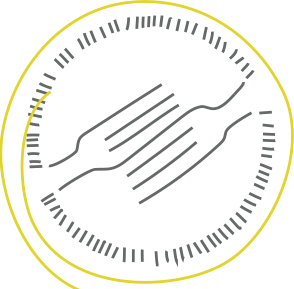Superficially Sweet
I was recently in Starbucks with my boys and Jack, my 7-year old, grabbed a small yellow “sugar” packet and said, “Mom, this is the bad stuff right?” My heart just swelled with pride! OK I admit it—I am grooming my child to be the next nutrition know-it-all!
If you don’t already know:
- The yellow packet is sucralose (Splenda)
- The pink one is saccharin (Sweet and Low)
- And the blue one is aspartame (Equal; and also NutraSweet)
And we can’t forget (though we don’t typically see either in packets rather they are often listed as an ingredient in many foods):
- Acesulfame Potassium (also called Sunett and Sweet One).
- Neotame (made by NutraSweet)
I have to share this with you cause it is priceless! The discovery of artificial sweeteners occurred in 1878 by a researcher working out of a lab at John’s Hopkins who noticed that a derivative of coal tar he accidentally spilled on his hand tasted sweet. His spill set the stage for the development of saccharin—the first artificial sweetener introduced to market.
I don’t know about you but I wouldn’t want to be eating anything that is a derivative of coal tar. That being said, these superficially sweet substances are FDA approved but are considered Generally Recognized as Safe (GRAS) meaning that either they are: (1) Deemed “safe” by FDA scientists for intended use; (2) or have a lengthy history of use in food and don’t require FDA approval before sale. Wow, that makes me feel a whole lot better!
So back to saccharin, in the 1970’s studies linked it to cancer in lab rats and because of these studies, saccharin once carried a warning label that consumption could be hazardous to your health. But apparently it is now in the clear, as newer studies have “confirmed” its safety. I remain skeptical when it comes to anything superficially sweet (or chemicalized in any way for that matter).
Why Do We Consume Them
Well, it’s pretty simple—they make our food sweet (anywhere from 30 to 8,000 times sweeter than sugar) WITHOUT the calories. While 1 gram of table sugar contains 4 calories, these superficial heroes have zero. And for a sugar and calorie obsessed nation that is a panacea—we can eat all the sweets we want without taking in any calories!
I know, you are probably thinking that these sweeteners are medically necessary for many—like our 25.8 million American’s living with diabetes (90-95% of whom have Type 2 Diabetes also called adult onset diabetes) or our grossly overweight and obese population. Well, this is what we are made to believe but the reality is that if you are diagnosed with diabetes, eating all the same stuff but with superficial sweetness is NOT GOING TO HELP—changing diet and exercising will. But please note that, shifting what you eat means eating a whole-foods based diet balancing each meal with healthy carbohydrates (vegetables, fruit, whole grains, legumes, nuts and seeds), protein and fat. And moderating real sugar is the key.
What’s Wrong With Them
Scientifically, apparently nothing is wrong with them despite the fact that studies have linked them to cancer in rodents. If you want to really explore these studies and their inherent controversies, check out what Center for Science in the Public Interest—one of my favorite industry watchdogs—has to say.
As for me, I like to look at a lot more than the science when it comes to making food choices—I call on logic (something many of us have a hard time tapping into when it comes to food). Do you honestly think that consuming something so superficial can be health supportive in any way whatsoever? The average American consumes 24 pounds of artificial sweeteners each year (that is roughly 48 cups). I like to look at it as drinking about 3 gallons of paint a year (for better or worse, they are chemicals).
Where Can We Find Them
- In yellow, pink and blue packets
- In large bags in the supermarket’s sugar isle telling us “great for baking”
- In most “zero”, “no calorie” and “no-sugar added” beverages
- In most “zero”, “no calorie” and “no-sugar added” foods including cookies, cakes, snack foods, salad dressings, marinades, frozen foods, baby food, yogurts
They are freakin’ everywhere! In fact, they are added to nearly 6,000 products in the US alone.
What Can We Use Instead of Them
Call me a purest, but I like to put stuff from nature, rather than a lab, in my body (except medically necessary medication). So, this is what I consider an authentically sweet arsenal:
Dry (all from sugar cane)
- Granulated white sugar (the stuff in white packets aka cane sugar)
- Confectioners sugar
- Florida Crystals
- Sugar in the raw (the stuff in brown packets)
- Brown sugar
- Date sugar
Liquid (all from different sources)
- Honey
- Maple syrup
- Agave nectar
- Brown rice syrup
- Barley malt
- Molasses
While I didn’t hit all sweeteners in this blog, I wanted to leave you with a landscape of the sweet (and not so sweet stuff). Our food is “sugared” with many substances, real or not, and they fall under four categories:
- Artificial sweeteners (like the ones dissected above)
- Sugar alcohols (like sorbitol, xylitol, mannitol)
- “Novel” sweeteners (like stevia and its derivatives such as Pure Via and Truvia)
- Natural Sweeteners (like the ones listed above)
Surely check out the Mayo Clinic for more in-depth info on this topic.
Have a sweet day though not superficially sweet! And stay tuned for some sweet treat recipes next week using some of my favorites!

